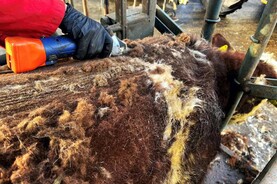Grazing conditions are good on livestock farms after fine weather over the past week. However, while cattle will hopefully remain at grass for at least another month, thoughts should be turning to preparing cattle sheds for the winter period.Take the time over the next week to check housing facilities and note down what repairs or modifications are required. Have these tasks carried out as soon as possible.
Grazing conditions are good on livestock farms after fine weather over the past week. However, while cattle will hopefully remain at grass for at least another month, thoughts should be turning to preparing cattle sheds for the winter period.
Take the time over the next week to check housing facilities and note down what repairs or modifications are required. Have these tasks carried out as soon as possible.
That way, housing facilities will be ready to take cattle should animals have to come in for the winter earlier than planned.
Outlined are five tasks to complete so that sheds are ready for winter.
1 Empty slurry tanks
Make sure all storage tanks have been emptied. Rainwater and silage effluent collected in tanks also need emptying before winter.
Ground conditions are generally good on farms after improved weather over the past two weeks, so take the opportunity to spread all remaining slurry before the closed period on 15 October.
With silage ground becoming available, there is additional grassland to take slurry. Avoid spreading slurry where lactating cows will be grazing in the next 10 to 15 days.
When working with slurry, always make safety a priority. Stay outside of sheds, keep children and pets away from filling and mixing points.
Finally, always replace safety guards over mixing/filling points when you leave the yard to empty the tanker.
2 Wash sheds
Have sheds been cleaned out and power washed after spring turn out? Clean sheds means there is no carry-over of disease from last year.
Clean all slats, walls, dividing gates and feed barriers. Where possible, clean cobwebs and dust from roofs, lights as well as space boards or tin.
Allow pens to dry out before animals are housed. Spreading hydrated lime around pens is a good idea after pens have dried.
3 Water provision
Are all drinkers in working order? Do water pipes need replaced or joints and fittings need fixed to prevent leaks? Do pipes which are prone to freezing need lagging applied?Is the size of the drinking trough adequate and is it located in a good position? Providing clean fresh water is crucial for cattle, especially finishing animals on a high-concentrate diet.
If the flow rate of water is not adequate, you should upgrade the supply to increase water availability.
Cattle queueing for water is a sign that water supply is inadequate. This will reduce feed intakes, which ultimately reduces weight gain and prolong the finishing period. This increases finishing costs.
4 Air flow
Is the airflow in cattle sheds adequate? Think back to previous winters to remember if there were problems with pneumonia in young stock.
Ideally, do a smoke test. Fill a bag, or an old oil barrel, with straw and set alight in a safe manner in cattle pens where animals will be standing.
Monitor the flow of smoke to see how it rises and exits the shed. Once the fire has been extinguished, smoke should be cleared from the shed inside five minutes.
If it takes longer, then you should take steps to alter the airflow in sheds.
5 General maintenance
Make sure all maintenance jobs are up to date. These include replacing light bulbs, fixing dividing gates and adjusting the position of feed barriers.
If any slats have become damaged, they should also be replaced now. Do not leave damaged slats in place as they may have weakened and when stressed under load, bigger problems may occur.
Read more
Listen: Taoiseach ‘would hate’ to return unspent BEAM money
Your view: what farmers thought of the beef talks





SHARING OPTIONS: